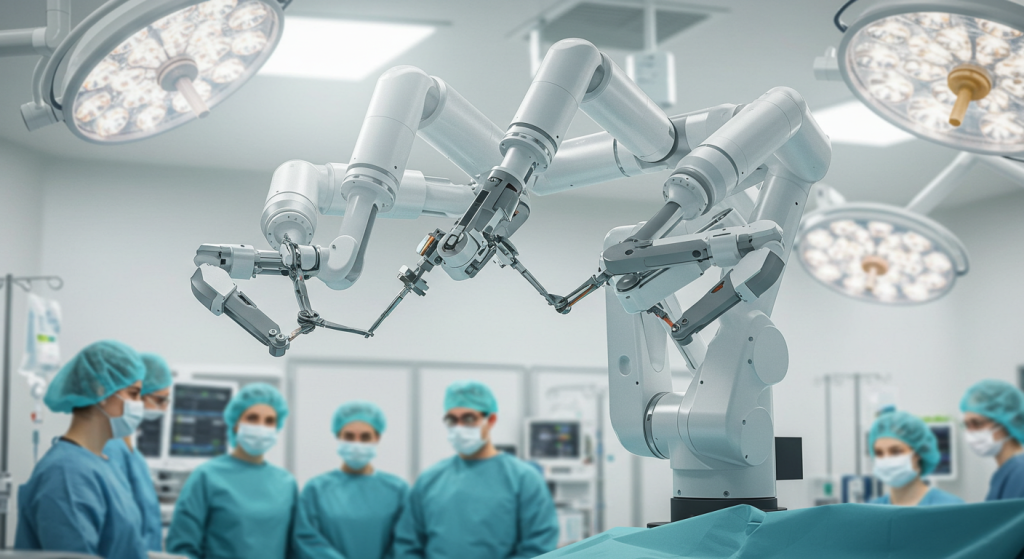Parallel Robots for Medical Applications: Enhancing Accuracy
What are Parallel Robots?
Parallel robots are also known as parallel manipulators. They are the robotics arms that essentially allow for robotics limbs to operate in tandem to maneuver across a platform or with a tool. While a traditional serial robot has one arm that processes around whatever its project is, a parallel robot has multiple components to try to achieve one singular goal. The multiple actuators and links allow for the components to work more efficiently as an assembly, which is often needed when tasks require a great deal of accuracy and precision, as in the case of parallel robots for medical applications.
WSC 1200D: Delta Robot Pick and Place for High-Speed, Precision Automation
The WSC 1200D Delta Robot Pick and Place is an innovative solution for industrial automation offering precision, speed, and versatile operation. With operations ranging from 60-120 times per minute, the WSC 1200D will meet your industrial requirements with superior construction and dependability. Whether sorting, packing, or placing, this parallel robot brings speed and accuracy to your industrial application.
Speed and Efficiency: 60-120 Times Per Minute
The WSC 1200D Delta robot boasts an operational speed of 60 to 120 cycles per minute, making this model a phenomenal addition to production and packaging settings where faster efficiency is needed. With the ability to operate at these rapid cycles, manufacturing plants can bolster their throughput exponentially while still reaping the benefits of accuracy.
Payload Capacity: 3kg, 8kg and 12kg Options
Another exciting feature of the WSC 1200D Delta robot is that it has the option for various payload capacities. The WSC 1200D can be tailored to match operational needs from 3kg, 8kg, or 12kg payloads. This means that the robot can pick up different parts, whether small and lightweight or larger and heavier. No matter what the operational challenges may be, the durable chassis of the WSC 1200D and its powerful actuators will provide the best movement and precision during use.
Single-Phase Power for Cost-Effective Operation
The operating power supply of the WSC 1200D Delta robot is a single-phase AC power supply with an input AC of 220V ±15%. It operates on 50/60Hz. Such low energy needs for operation make the machine not only cost-effective for manufacturers in the long term for energy savings but also easy to use as it plugs right into the warehouse power source. Such cost-effective options for operation make this machine highly desirable in situations where every penny counts.
Large Travel and High-Speed Performance
Another highlight of the parallel robots for medical applications is their substantial travel. With a stroke of up to 1200mm, this Delta robot travels great distances in short amounts of time. This large effective radius means that the robot can be used in larger-scale applications that require longer distances, like assembly, sorting, and larger-scale packaging. Thus, the perfect balance of travel and speed means that the WSC 1200D can accomplish more demanding jobs up to standards.
Why Choose the WSC 1200D Delta Robot?
Flexibility: Different payloads and travel ranges mean that the WSC 1200D can be used in a variety of fields and applications, from packaging and sorting to medical surgeries and microsurgeries.
Speed: Up to 120 cycles per minute, this robot will keep your production line moving at full steam while still maintaining high accuracy.
Value: The WSC 1200D is low maintenance, low power consumption, and energy conscious, meaning the long-term value of this unit outweighs any short-term costs.
Accuracy and Repeatability: With a repeat positioning accuracy of ±0.05mm, the robot boasts the level of precision and care required to adjust even the smallest components reliably.
Easy Integration: The robot integrates easily into pre-existing production platforms. This makes it an ideal choice for manufacturers looking to incorporate automation into their operations without extensive changes to their current systems.

Medical Applications of Parallel Robots
Parallel robots are utilized in various fields of medicine. The most crucial include:
Stereotactic Surgeries
Stereotactic surgeries are those that require the ability to find and navigate a specific location in the brain using a set path of pre-determined coordinates. Therefore, parallel robots are required in this surgery to improve accuracy and decrease the risks that come with traditional surgeries. Stereotactic surgery includes hexapod robots and Stewart platforms for tremor elimination and deep brain stimulation.
Prostate and Cardiac Surgery
Parallel robots apply to prostate surgery and heart surgeries, as well. For prostate surgery, prostatectomies are performed, and the Da Vinci Surgical System allows for precision in the area. In heart surgery, precision is similarly needed in coronary artery surgeries; thus, parallel robots apply here, as well.
Endoscopy and Biopsy
Endoscopy and biopsies use parallel robotics, as well. With an endoscopic procedure, the use of the camera allows a practitioner to see exactly what is going on in the field, and robotics can provide steady assistance. Robotic biopsy systems can ensure that proper biopsies are received and not veered away from the intended site.
Drug Delivery Systems
Aside from surgical applications, there have been drug delivery systems via parallel robotics, as well. Parallel robots allow for assured delivery of drugs out in the field when human help can be fallible.
Conclusion
The state of the art shows that parallel robots are changing medicine with greater precision, accuracy, and time efficiency. Whether it's a parallel robotic-assisted minimally invasive surgical approach or co-robotic assisting in rehabilitation, parallel robot technology is already present in the transformation of the industry. And as more robots come equipped with more elaborate designs, embedded sensors, and accurate control systems, the only thing that inhibits us is our imagination. What's in the pipeline are even more creative interventions within the medical fields that need adaptive technology; medical professionals must remain aware and open to the developments of parallel robotics for further medical applications. Read more about parallel robots in medical applications.















